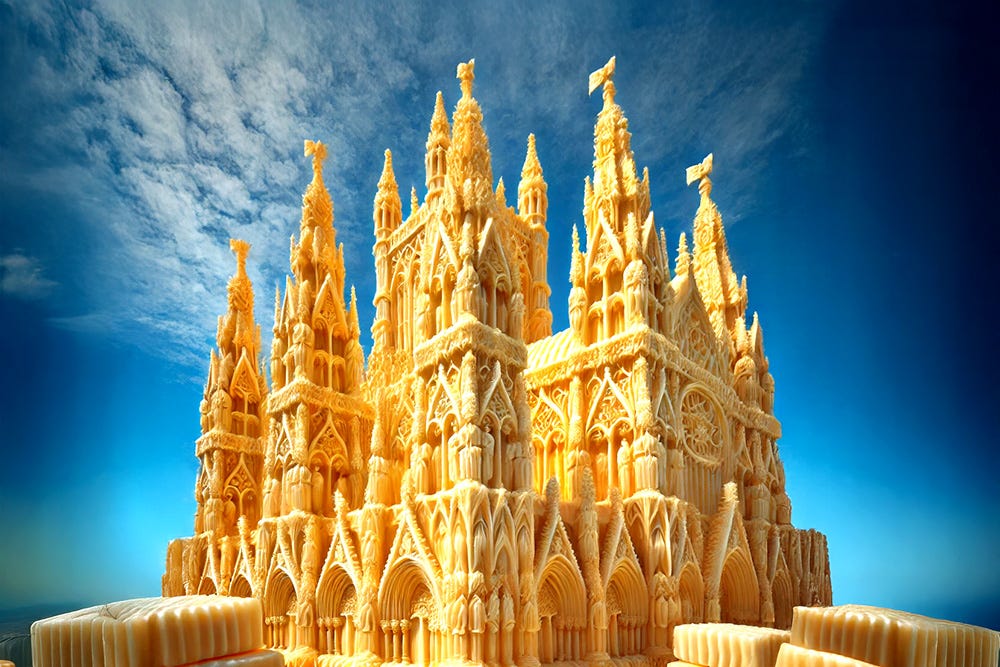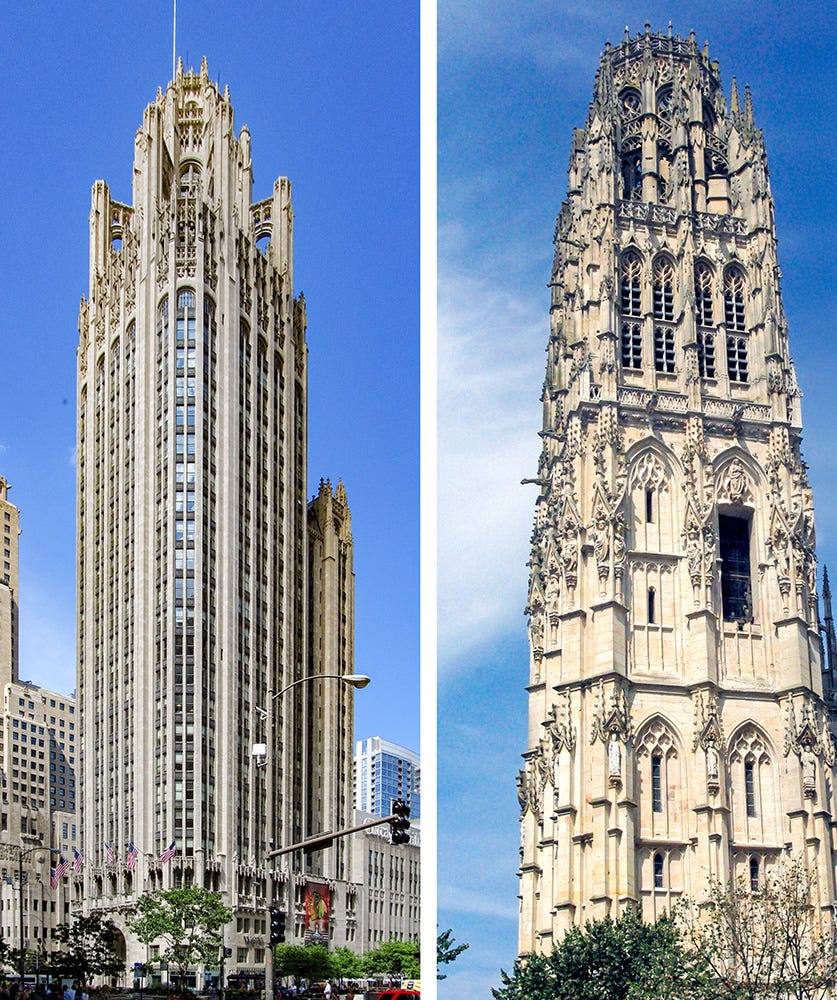A Gothic Marvel Funded by Butter? The Curious History of Rouen Cathedral
How did a 15th-century cathedral tower get named after butter? A tale of indulgences, medieval loopholes, and the Normans’ undying love for dairy—unraveling a curious story behind Rouen Cathedral.
Mardi Gras has come and gone.
The feasting, the pancakes, the indulgence—all behind us.
And now, according to tradition, we’ve entered a very different time of year: Lent.
A season of restraint, of fasting, of giving things up.
No more rich foods, no more lavish meals—just simple, humble fare until Easter.
At least, that’s how it was supposed to be.
But let’s be honest—people have never been great at following strict rules, especially when it comes to food.
Which is why, back in the late 15th century, the people of Rouen came up with a rather clever workaround.
They still wanted their butter.
And thanks to the right amount of persuasion (or should we say donations), they got permission from the Church to keep eating it during Lent—for a price.
And that price?
It helped build one of the most spectacular towers in France.
So, why does Rouen Cathedral have a Tour de Beurre—a "Butter Tower"?
Well, there are two theories. And I’ll be honest—one of them makes a lot more sense than the other.
A Tower the Colour of Butter?
Let’s start with the simple explanation.
Unlike the rest of Rouen Cathedral, built mostly from the pale, almost chalky limestone of Caumont, the Tour de Beurre was made from a different kind of stone, a yellowish limestone sourced from Saint-Leu-d'Esserent, a town northeast of Paris.
This gave the tower a distinctive golden hue—a bit like a giant slab of butter melting in the Norman sun (or in the rain, more realistically).

Nice theory, right? Except… it’s almost certainly not true.
I mean, let’s be real—if we named every building after its colour, we’d have ‘Beige Tower’, ‘Dusty Grey Church’, and ‘Mildly Off-White Castle’ scattered across France.
The real reason? It has a lot more to do with money.
When Butter Paid for a Cathedral
So here’s the thing: back in the late 15th century, Rouen Cathedral was missing something.
It had the Tour Saint-Romain, the older of its two main towers, standing proudly on the left side of the façade.
But on the right? Nothing. Just an awkward, empty space that made the whole thing look… off-balance.
Enter Guillaume Pontif, the master builder put in charge of fixing this.
In 1485, under the archbishop Robert de Croismare, he laid the first stone of what would become the Tour de Beurre.
Construction was an expensive business, though, and money didn’t just appear out of thin air.
That’s where the indulgences came in.
Now, indulgences were a big deal in the Middle Ages.
The Church essentially allowed people to pay for a reduction in the punishment for their sins—a spiritual get-out-of-jail card, if you will.
And in the case of Rouen Cathedral, the deal was this: if you made a financial contribution, you’d receive permission to eat butter during Lent.
Yes, butter.
At the time, Lent (Carême in French) was a season of fasting and self-denial, leading up to Easter.
The rules were strict: no meat, no dairy, no eggs.
But Normandy—well, Normandy is butter country.
And telling Normans they couldn’t have butter? That was never going to fly.
So, the cathedral’s canons petitioned the Pope, got permission to offer this special indulgence, and soon enough, wealthy Rouennais were happily smearing butter on their bread all through Lent—while also funding the construction of a stunning new tower.
A win-win, really.
Oh, and by the way—this wasn’t just a Rouen thing.
The same strategy was used to finance another ‘Butter Tower’ at Bourges Cathedral.
Because if there’s one thing medieval clergy understood, it’s that people will always pay for their guilty pleasures.
A Tower of Excess (in More Ways Than One)
And speaking of bells, the Tour de Beurre once housed one of the largest carillons in France.
Over time, it was expanded and modernised—until, in 2015, the decision was made to relocate the carillon to the Tour Saint-Romain.
To make this possible, the bells were carefully removed and sent to the Paccard Bell Foundry in Annecy, a legendary name in bell-making, where they were either restored or recast.
The foundry, which has been crafting bells since 1796, has left its mark on some of the most famous towers in the world—including Notre Dame de Paris.
Today, the Tour de Beurre still holds six bells, but its days as Rouen’s musical heartbeat are largely behind it.
The grand carillon that once rang out from its heights now chimes from across the cathedral, its sound still echoing through the city—just from a different tower.
Legacy: The Butter Tower Goes Global
The Tour de Beurre may not be Rouen’s tallest structure—that title goes to the cathedral’s famous iron spire, which soars 151 metres into the sky.
It’s not even the most famous part of the cathedral (thank you, Monet, for making the façade world-famous).
But it does have one unexpected claim to fame: it inspired a skyscraper in Chicago.
No joke.
When architects designed the Tribune Tower in the 1920s, they drew inspiration from the Flamboyant Gothic architecture of Rouen Cathedral.

And as if to make the connection even more explicit, they embedded an actual fragment of Rouen’s Tour de Beurre into the building’s façade.
So, next time you’re in Chicago, strolling past the Tribune Tower—look closely.
A little piece of Rouen is right there, thousands of miles from its buttery birthplace.
Final Thoughts (and a Warning About Lent Indulgences…)
The Tour de Beurre is more than just an architectural wonder—it’s a reminder of a time when religion, money, and daily life were intimately connected.
When something as simple as butter could change the skyline of a city.
And honestly? It’s a bit of a relief that the Church eventually stopped selling indulgences like this.
Otherwise, who knows? We might have ended up with a Cheese Cathedral, a Wine Belfry, and a Chocolate Cloister.
…Actually, now that I think about it, that doesn’t sound too bad. 😅
For More Information on Rouen
If this article has sparked your curiosity about Rouen and its rich history, here are some additional resources to help you explore the city and plan your visit.
Further Reading on Rouen
The old town of Rouen – Discover the city’s lesser-known gems, from picturesque alleyways to fascinating historical anecdotes.
The Cathedral of Rouen – A guide to the local dishes you must try during your stay.
The history of Rouen – The main dates that made the capital of Normandy.
Where to Stay in Rouen
To make the most of your visit, choosing the right accommodation is key. Here are some recommended hotels in Rouen:
Hôtel Paulette Rouen Centre – Just a 5-minute walk from Rouen Cathedral and the Gros-Horloge, this stylish and welcoming boutique hotel offers 22 elegantly decorated rooms.
Radisson Blu Hotel, Rouen Centre – A modern hotel with spacious rooms and high-quality service, ideally located for exploring the city. [Affiliate link to booking platform]
Hôtel Littéraire Gustave Flaubert – Step into the world of the famous Norman writer by staying at this literary-themed hotel in the heart of Rouen. [Affiliate link to booking platform]
👉 Click here for a full list of accommodations in Rouen!
💡 Note: The affiliate links above allow you to book your stay while supporting our blog at no extra cost to you.
Getting to Rouen from Paris
Rouen is easily accessible from Paris, making it a perfect destination for a day trip or a weekend getaway.
Direct trains depart from Gare Saint-Lazare in Paris and reach Rouen-Rive-Droite station in around 1h14 on the fastest routes.
Trains run frequently throughout the day, ensuring a smooth and convenient journey.











Ha! I guess you could say they had to butter the clergy up 😅🧈⛪ Cool tidbit! Thanks for sharing, Pierre!